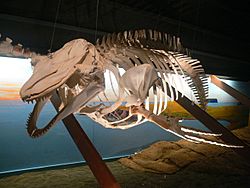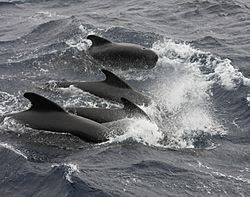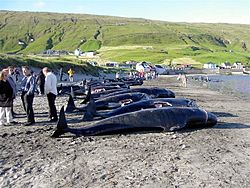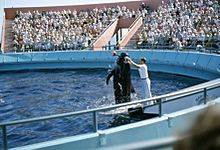Pilot whale facts for kids
Quick facts for kids Pilot whalesTemporal range: Pliocene to recent
|
|
|---|---|
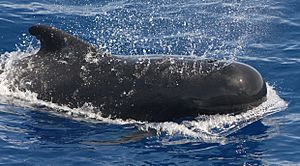 |
|
 |
|
| Size of short-finned pilot whale compared to an average human | |
| Scientific classification |
|
| Kingdom: | Animalia |
| Phylum: | Chordata |
| Class: | Mammalia |
| Order: | Artiodactyla |
| Infraorder: | Cetacea |
| Family: | Delphinidae |
| Genus: | Globicephala Lesson, 1828 |
| Type species | |
| Delphinus globiceps Cuvier, 1812
|
|
| Species | |
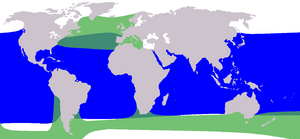 |
|
| Exclusive range of short-finned pilot whale Exclusive range of long-finned pilot whale Regions of sympatry | |
| Synonyms | |
|
Globicephalus |
|
Pilot whales are large oceanic dolphins. They belong to a group of animals called cetaceans, which includes whales, dolphins, and porpoises. There are two main types of pilot whales alive today: the long-finned pilot whale and the short-finned pilot whale.
It's hard to tell the two types apart just by looking at them in the ocean. Scientists usually need to study their skulls to know the difference. Long-finned pilot whales prefer colder waters, while short-finned pilot whales live in warmer, tropical areas. Pilot whales are some of the biggest dolphins, only smaller than the orca. They are also sometimes called "blackfish."
Pilot whales mainly eat squid, but they also hunt large fish like cod. They are very social animals and often stay with their family group, called a pod, for their whole lives. Female short-finned pilot whales are one of the few mammals that go through menopause. Even after they can't have babies, these older females help their pod.
Pilot whales are known for getting stranded on beaches. Scientists think this might happen because loud noises in the ocean, like from ships, can damage their inner ear, which they use for finding their way. Both types of pilot whales are currently listed as "least concern" for their survival.
Contents
Why They Are Called Pilot Whales
These whales got their name because people used to believe that a leader "piloted" or guided their groups. They are also known as "pothead whales" because of their round heads, and "blackfish" due to their dark color. The scientific name for their group, Globicephala, comes from Latin and Greek words meaning "round ball" and "head."
Pilot Whale Family Tree
Pilot whales are divided into two species: the long-finned pilot whale (Globicephala melas) and the short-finned pilot whale (G. macrorhynchus). Scientists first described the short-finned pilot whale in 1846 by studying its bones. The long-finned pilot whale was first named in 1809.
Scientists have found fossils of ancient pilot whales. For example, a fossil of Globicephala etruriae was found in Italy. This helps us understand how pilot whales have changed over millions of years.
What Pilot Whales Look Like
Pilot whales are usually dark grey, brown, or black. They have some lighter spots, like a grey patch behind their dorsal fin (the fin on their back). They also have a light, anchor-shaped patch under their chin and a large marking on their belly. Their dorsal fin is set forward on their back and curves backward.
Pilot whales are stronger and more solid than most dolphins. They have a very noticeable large, round forehead called a melon. Their long, curved flippers and tail are flattened from side to side. Male long-finned pilot whales tend to have rounder melons than females.
It's hard to tell the two species apart just by looking at them. Scientists used to try to tell them apart by the length of their flippers and the number of teeth. However, they found that these features often overlap. So, now biologists mainly use differences in their skulls to identify the two species.
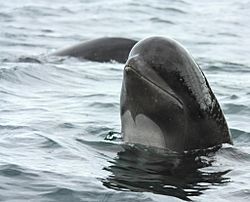
Long-finned pilot whales are generally bigger than short-finned pilot whales. Both species can live for about 45 years if they are male, and up to 60 years if they are female. Males are usually larger than females. Adult long-finned pilot whales can be about 6.5 meters (21 feet) long, with males being about 1 meter (3 feet) longer than females. Males can weigh up to 2,300 kg (5,070 pounds). Short-finned pilot whale females reach about 5.5 meters (18 feet) long, while males can be up to 7.2 meters (24 feet) long and weigh up to 3,200 kg (7,050 pounds).
Where Pilot Whales Live

Pilot whales live in oceans all over the world. Long-finned pilot whales prefer cooler waters. One large group lives in the Southern Ocean, near places like Chile, Argentina, South Africa, Australia, and New Zealand. Another very large group lives in the North Atlantic Ocean, from the United States to Morocco and up to Greenland and Norway. They are also found in the western Mediterranean Sea.
Short-finned pilot whales live in warmer, tropical waters in the Indian, Atlantic, and Pacific Oceans. Their areas sometimes overlap with long-finned pilot whales in temperate waters. Pilot whales usually travel around, but some groups stay in places like Hawaii and parts of California all year. They like to live near the edge of the continental shelf, where the ocean floor drops off.
Pilot Whale Behavior and Life Cycle
What Pilot Whales Eat

Pilot whales mostly eat squid. They also eat fish like cod, mackerel, and herring. They move closer to shore or further out to sea depending on where their food is.
Pilot whales usually take several breaths before diving underwater for a few minutes. When they are hunting for food, their dives can last over ten minutes. They can dive as deep as 600 meters (about 2,000 feet), but most of their dives are between 30–60 meters (100–200 feet). They tend to make shallow dives during the day and deeper dives at night. When diving deep, pilot whales often swim very fast to catch quick-moving prey like squid.
Social Life of Pilot Whales
Both types of pilot whales live in groups, or pods, of 10 to 30 individuals. Some pods can even have 100 or more whales! These pods are very stable, and the whales in them are usually closely related, often through their mothers. Pods include whales of all ages and sexes, though there are usually more adult females than males. They help each other, sometimes even sharing food. Many pods might gather together temporarily. This allows whales from different pods to meet and mate, and also provides more protection.
Male and female pilot whales usually stay with their mother's pod for their whole lives. However, when different pods gather, males will temporarily leave their own pod to mate with females from other pods. After mating, a male pilot whale usually stays with a female for only a few months. He might have several babies with females in the same pod. When the large gatherings break up, males return to their own pods.

Scientists have observed pilot whale pods in different groups:
- Traveling/Hunting groups: Whales spread out in a line, sometimes two miles long, with only a few whales underneath.
- Feeding groups: Whales are loosely together but move in the same direction while hunting.
- Loafing groups: 12 to 30 whales rest together. This is when mating and other social behaviors might happen.
Reproduction and Life Cycle
Pilot whales have one of the longest times between births among cetaceans, having a calf only every three to five years. For long-finned pilot whales, most mating and births happen in the summer. For short-finned pilot whales, the timing of births can vary. Pregnancy lasts 12–16 months for long-finned pilot whales and 15 months for short-finned pilot whales.
A calf will nurse for a very long time, usually 36–42 months. This creates strong bonds between mothers and their calves. Young pilot whales might even drink milk until they are 13–15 years old! Female short-finned pilot whales go through menopause, meaning they stop being able to have babies. These older females play important roles in helping the young whales survive. They might continue to produce milk and nurse young, even if they are not their own. Since they can't have more babies, they invest their energy in helping the current young thrive.
Short-finned pilot whales grow more slowly than long-finned pilot whales. Female short-finned pilot whales become ready to have babies around 9 years old, and males around 13–16 years. For long-finned pilot whales, females mature around eight years, and males around 12 years.
Pilot Whale Sounds
Pilot whales make different sounds. They use clicks for echolocation, which helps them find food. They also use whistles and other sounds to communicate with each other, like staying in touch with their pod members. When they are very active, their sounds are more complex. When they are resting, their sounds are simpler.
The two species have different calls. Long-finned pilot whales have lower-frequency calls than short-finned pilot whales. For example, when long-finned pilot whales are resting, they make simple whistles. When they come to the surface, they make more complex whistles and pulsed sounds. The more spread out the whales are, the more whistles they make to stay in contact.
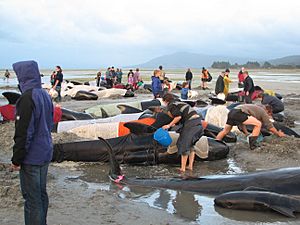
A study of short-finned pilot whales near Tenerife found that each pod has its own unique set of calls to keep in touch. When these whales dive deep to hunt, they make tonal calls. The number and length of their calls seem to decrease the deeper they go, even though they are further from other whales at the surface. This suggests that the water pressure affects the energy of their calls.
When pilot whales are stressed, they make "shrills" or "plaintive cries," which are variations of their whistles. Long-finned pilot whales off Australia have even been seen copying the calls of orcas. This behavior is thought to scare away orcas when pilot whales are looking for food.
Pilot Whales and Other Animals
Pilot whales have sometimes been seen chasing other types of dolphins and whales. In some places, like Iceland, long-finned pilot whales often chase killer whales. Scientists aren't sure why they do this. It might be because they are competing for food, or it could be a way to protect themselves from predators. In 2021, a female killer whale was seen with a newborn pilot whale off Iceland, which made scientists wonder if their relationship is more complicated than previously thought.
Why Pilot Whales Strand Themselves
Pilot whales are one of the most common types of whales to get stranded on land. Because they have such strong social bonds, entire groups of pilot whales will sometimes strand together. Single whales that strand are usually sick. However, group strandings often involve mostly healthy whales.
Scientists have several ideas about why group strandings happen. One idea is that whales use the Earth's magnetic fields to navigate, and they might get confused by unusual magnetic areas. Another idea is that they might be following a sick member of their group who got stranded. Or, if an important whale gets stranded, the rest of the pod might follow and keep returning to the beach because of their strong social bonds. In New Zealand, researchers have successfully used this social behavior to help stranded pilot whales. They took young whales offshore to buoys, and the distress calls of the young whales lured the older whales back out to sea.
In September 2022, nearly 200 pilot whales died after stranding on a beach in Tasmania, Australia. Only about 35 of the 230 stranded whales survived.
Pilot Whales and Humans
The IUCN lists both long-finned and short-finned pilot whales as "least concern" on their Red List of Threatened Species. This means their populations are not currently at high risk.
Hunting Pilot Whales
Pilot whales have been hunted for a long time, especially the long-finned pilot whale. This was often done by "driving" them. Many hunters in boats would form a semicircle behind a group of whales near the shore and slowly guide them into a bay. Once the whales were stranded, they were then killed. This practice was common in the 1800s and 1900s. Whales were hunted for their bones, meat, oil, and for fertilizer. In the Faroe Islands, pilot whale hunting has happened since at least the 1500s and continues today, though with fewer whales killed than in the past.
The short-finned pilot whale has also been hunted for centuries, especially by Japanese whalers. In the mid-1900s, thousands of short-finned pilot whales were hunted each year in Japan. By the 1990s, this number had dropped to about 400 per year.
Pilot whales can also be accidentally caught in fishing nets, which is called bycatch. This has happened in fisheries that catch squid and mackerel.
Pollution and Pilot Whales
Like other marine mammals, pilot whales can be affected by pollution in the ocean. Studies have found high levels of chemicals like DDT and PCB in pilot whales from places like the Faroes, France, the UK, and the eastern US. These pollutants can be passed from mothers to their babies during pregnancy and nursing. Whales from the Faroes have also been found to have high levels of cadmium and mercury.
Pilot Whale Meat

Pilot whale meat is eaten in a few places, mainly along the central Pacific coast of Japan and in the Faroe Islands. The meat is high in protein and low in fat. Because the fat is in a layer under the skin, the muscle meat is very dark red. In Japan, pilot whale meat is sometimes eaten raw as sashimi, or it can be marinated and grilled.
However, in both Japan and the Faroe Islands, the meat can contain high levels of mercury and cadmium. This can be a health risk for people who eat it often, especially children and pregnant women. Because of this, health officials in the Faroe Islands have recommended that people should no longer eat pilot whale meat due to the contamination.
Pilot Whales in Aquariums
Pilot whales, mostly short-finned pilot whales, have been kept in aquariums and oceanariums since the late 1940s. Some long-finned pilot whales were also kept temporarily. Several pilot whales from California and Hawaii were taken into captivity in the 1960s and 1970s, including some at SeaWorld San Diego.
Historically, pilot whales did not live very long in captivity. However, there have been some exceptions. Bubbles, a female short-finned pilot whale, lived to be over 50 years old in captivity before she passed away in 2016. In 1968, a pilot whale named Morgan was trained by the U.S. Navy to retrieve objects from the ocean floor. Morgan dove to a record depth of 1654 feet (504 meters).
Pilot Whales in Films
There are two documentaries that focus entirely on pilot whales:
- Full-length Cheetahs of the Deep (2014, directed by Rafa Herrero Massieu) — This film shows the life, social interactions, hunting, games, and breeding of a group of short-finned pilot whales that live between the islands of Tenerife and La Gomera in the Canary Islands. A special feature of the film is that all the marine mammals were filmed while the divers were free-diving (without breathing equipment).
- Short film My Pilot, Whale (2014, directed by Alexander and Nicole Gratovsky) — This film explores how humans can interact with wild pilot whales. It asks philosophical questions about cetaceans, such as how they view the world, what we have in common with them, and what humans can learn from them. The film has won several awards at international film festivals.
Images for kids
-
A pilot whale spyhopping
-
Volunteers attempt to keep body temperatures of beached pilot whales from rising at Farewell Spit, New Zealand.
See also
 In Spanish: Calderones para niños
In Spanish: Calderones para niños



